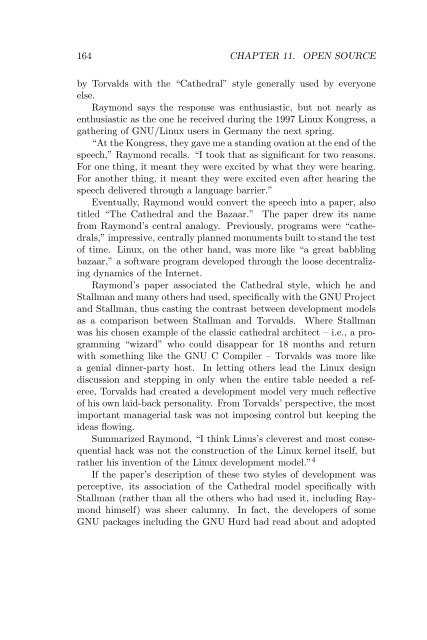Create successful ePaper yourself
Turn your PDF publications into a flip-book with our unique Google optimized e-Paper software.
164 CHAPTER 11. OPEN SOURCE<br />
by Torvalds with the “Cathedral” style generally used by everyone<br />
else.<br />
Raymond says the response was enthusiastic, but not nearly as<br />
enthusiastic as the one he received during the 1997 Linux Kongress, a<br />
gathering of GNU/Linux users in Germany the next spring.<br />
“At the Kongress, they gave me a standing ovation at the end of the<br />
speech,” Raymond recalls. “I took that as significant for two reasons.<br />
For one thing, it meant they were excited by what they were hearing.<br />
For another thing, it meant they were excited even after hearing the<br />
speech delivered through a language barrier.”<br />
Eventually, Raymond would convert the speech into a paper, also<br />
titled “The Cathedral and the Bazaar.” The paper drew its name<br />
from Raymond’s central analogy. Previously, programs were “cathedrals,”<br />
impressive, centrally planned monuments built to stand the test<br />
of time. Linux, on the other hand, was more like “a great babbling<br />
bazaar,” a software program developed through the loose decentralizing<br />
dynamics of the Internet.<br />
Raymond’s paper associated the Cathedral style, which he and<br />
Stallman and many others had used, specifically with the GNU Project<br />
and Stallman, thus casting the contrast between development models<br />
as a comparison between Stallman and Torvalds. Where Stallman<br />
was his chosen example of the classic cathedral architect – i.e., a programming<br />
“wizard” who could disappear for 18 months and return<br />
with something like the GNU C Compiler – Torvalds was more like<br />
a genial dinner-party host. In letting others lead the Linux design<br />
discussion and stepping in only when the entire table needed a referee,<br />
Torvalds had created a development model very much reflective<br />
of his own laid-back personality. From Torvalds’ perspective, the most<br />
important managerial task was not imposing control but keeping the<br />
ideas flowing.<br />
Summarized Raymond, “I think Linus’s cleverest and most consequential<br />
hack was not the construction of the Linux kernel itself, but<br />
rather his invention of the Linux development model.” 4<br />
If the paper’s description of these two styles of development was<br />
perceptive, its association of the Cathedral model specifically with<br />
Stallman (rather than all the others who had used it, including Raymond<br />
himself) was sheer calumny. In fact, the developers of some<br />
GNU packages including the GNU Hurd had read about and adopted


